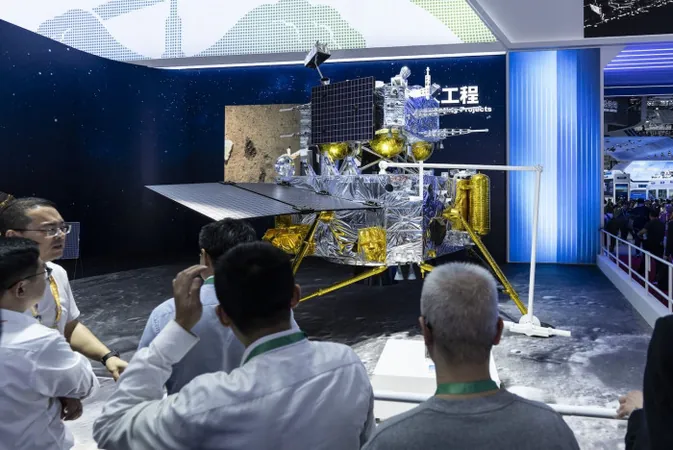
Groundbreaking Discovery: Chinese Probe Unveils the Oldest Lunar Volcano Evidence!
2024-11-16
Author: Sophie
Introduction
In a historic achievement, China's Chang'e-6 robotic spacecraft has returned the first surface samples from the moon's far side, a realm forever hidden from Earth’s view, and made waves in our understanding of the moon's geological past. The findings not only shed light on the moon's history but reveal the oldest evidence of volcanic activity, dating back an astounding 4.2 billion years.
Key Findings
On Friday, researchers announced that lunar soil collected from the Chang'e-6 landing site includes fragments of ancient basaltic rock, with ages of 4.2 billion and 2.8 billion years. This indicates that intense volcanic activity persisted on the moon's far side for at least 1.4 billion years. During this time, the moon was a far more dynamic and geologically active environment than we observe today.
Volcanic History of the Moon
The moon, formed around 4.5 billion years ago, underwent a series of volcanic eruptions similar to those on Earth. These eruptions arise when molten rock from beneath the crust breaks through to the surface, often reshaping the landscape. Chang'e-6 touched down in the South Pole-Aitken Basin, the largest impact crater on the moon and an area renowned for its thin crust, making it an ideal location for geological investigations.
Sample Collection and Analysis
Using a specialized scoop and drill, the Chang'e-6 mission successfully retrieved approximately 1,935 grams of lunar soil, which was then delivered back to Earth, safely landing in Inner Mongolia. “The Chang’e-6 samples provide a unique opportunity to study far side volcanism,” stated Qiu-Li Li, a lunar scientist with the Chinese Academy of Sciences and lead researcher of the study published in the esteemed journals Nature and Science.
The analysis revealed a variety of volcanic rock fragments. Scientists employed a cutting-edge technique known as radioisotope dating to ascertain their ages accurately. Prior to Chang'e-6, lunar basalt samples had only been collected from the moon's near side through the Apollo, Luna, and Chang'e-5 missions. These earlier samples indicated volcanic activity that dated back to around 4.0 billion years, enduring for at least two billion years.
Complexities of Lunar Volcanism
However, the quest to comprehend lunar volcanism remains complex. Li emphasized that volcanic activity likely varied between regions of the moon, with intriguing hints suggesting some small-scale eruptions might have occurred on the near side as recently as 120 million years ago, as evidenced by volcanic glass beads from Chang'e-5 samples collected in 2020.
Differences in Basalt Samples
One striking revelation from the recent analysis is that the basalt samples dating to 4.2 billion years ago differ in composition from those dating to 2.8 billion years ago, indicating they originated from distinct molten rock sources in the moon's mantle. Furthermore, the Chang'e-6 samples also exhibited compositional differences compared to previously collected near-side samples, expanding our understanding of the lunar surface's diversity.
Current Volcanic Activity
While the study unveils a rich volcanic history, researchers confirmed that the moon currently has no volcanic activity — a stark contrast to volcanic activity observed on Earth and other celestial bodies like Venus. Li attributes this cessation to the moon's dwindling internal heat sources, driven initially by the decay of radioactive elements and the residual heat from its formation. Over billions of years, as these heat sources diminished, the moon's mantle cooled and solidified, significantly reducing magma's ability to reach the surface.
Conclusion
The moon, with a diameter of about 3,475 km, is a little over a quarter the size of Earth, contributing to its rapid cooling rate. Ultimately, this cooling led to a drop in the interior temperature below the threshold necessary for volcanic activity, permanently marking the end of substantial eruptions on our lunar neighbor.
As we stand on the brink of further exploration and understanding of our celestial companions, the Chang'e-6 mission continues to pave the way for groundbreaking discoveries about the moon and its complex geological history. What other secrets does the moon hold? Only time and continued exploration will tell!









 Brasil (PT)
Brasil (PT)
 Canada (EN)
Canada (EN)
 Chile (ES)
Chile (ES)
 España (ES)
España (ES)
 France (FR)
France (FR)
 Hong Kong (EN)
Hong Kong (EN)
 Italia (IT)
Italia (IT)
 日本 (JA)
日本 (JA)
 Magyarország (HU)
Magyarország (HU)
 Norge (NO)
Norge (NO)
 Polska (PL)
Polska (PL)
 Schweiz (DE)
Schweiz (DE)
 Singapore (EN)
Singapore (EN)
 Sverige (SV)
Sverige (SV)
 Suomi (FI)
Suomi (FI)
 Türkiye (TR)
Türkiye (TR)